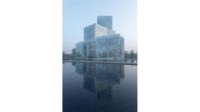Amanda Burden in the Zone
The first thing he said was that we are a city of five boroughs — Staten Island, the Bronx, Brooklyn, Queens — not just Manhattan. He wanted to see economic opportunity encouraged in each. Since the city is expected to expand to 9.1 million people by 2030, we had to figure out how and where it should grow. Our goal was to direct development to centers of transit in downtown Brooklyn or Jamaica, Queens, or Long Island City — or to 125th Street — by creating mixed-use regional business districts that would provide jobs, new housing, and taxes.
We sought to preserve the DNA and the character of each neighborhood by working with communities to develop plans to accommodate growth. For example, the Coney Island initiative aims to recapture what was so special about the area’s great beach, boardwalk, and amusements. Yet the rides are a seasonal event, and they have been closing one by one. Through zoning we created an indoor and outdoor entertainment and amusement district to last year-round.
At the same time the mayor started the largest affordable housing program in the country both to accommodate existing New Yorkers and arriving New Yorkers. He called for 165,000 new affordable units by 2013.
Our inclusionary housing program gives a bonus within a height limit to a developer providing 20 percent affordable housing.
The High Line
Before 2002, the High Line, a mile-and-a-half elevated former railway, was slated for demolition, but I knew this incredible piece of urban infrastructure could become the defining feature of a new neighborhood. The High Line was owned by the federal government — by CSX Transportation. It was willing to transfer the railroad to the city for nothing, but only if every single property owner in the area approved. People who owned land under and adjacent to the High Line opposed it, since they wouldn’t realize the value for their property. So we used the old zoning tool of a transfer of development rights to create the Special West Chelsea district.
If you owned land within this special district, under or adjacent to the High Line, you could transfer and sell your property rights to a property owner on 10th or 11th Avenues. Property owners were deliriously happy. The city acquired the High Line from CSX.
To protect the integrity of this beautiful garden in the sky, and keep light, air, and its character as a garden, we formed strict design controls — not only height limits, but restrictions on how much of a block could be developed, and how far away from the High Line you had to put your buildings.
Hudson Yards
When Mayor Bloomberg was elected, Midtown Manhattan could really only expand on the west side, from Times Square to 30th Street, Eighth Avenue to the Hudson River. We created an urban design master plan to redefine a mostly industrial area — 59 blocks — as a new central business district, with infrastructure, parks, and public open space next to the waterfront. We even put a new boulevard between 10th and 11th Avenues. And through rezoning from industrial use to residential and commercial ones, we had $2 billion for new infrastructure, especially the extension of the No. 7 subway line from Times Square, west across 41st Street and down 11th Avenue.
A big portion of the district is in fact the rail yards, controlled by the MTA, which awarded Related Companies the right to develop on those yards. And Related Companies hired Kohn Pedersen Fox to do its master plan (see page 138 for details). The Floor Area Ratio (FAR) in the zoning district is very high to encourage development, although there are prescriptive requirements for street walls in certain places. The actual rail yards have an even higher density, since the streets aren’t mapped: some buildings can have a 30 FAR and may be well over 1,000 feet tall.
PLANYC
PlaNYC is an incredibly important legacy of the Bloomberg administration. It’s our blueprint for sustainability — cleaner air and water, with a healthier lifestyle for New Yorkers. We have been focusing on energy efficiency, looking at our zoning code and seeing how we can eliminate impediments to it by using solar or wind sources, or through insulation. We’re looking at ways to incentivize energy efficiency and energy generation. It’s a key initiative of these next 800 days we have here.







